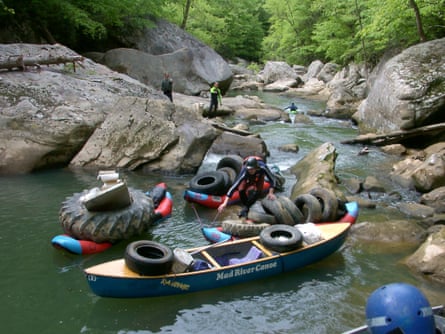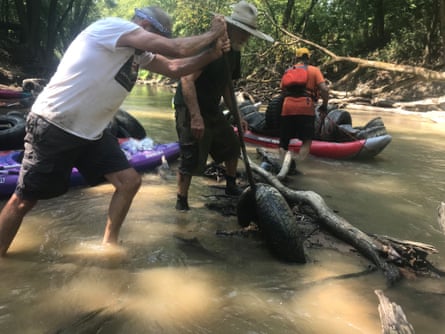In the 1980s, Russ Miller and his wife moved to a far edge of eastern Kentucky’s Red River Gorge, where they built a homestead on a ridge hugged by three sides of the river. It’s the kind of place you can only get to with a hand-drawn map. A place so remote that the farther and farther you drive to get to it, the more unsure you are that you are in the right place.
They would spend leisurely afternoons drifting the river in inner tubes, until they started noticing what floated alongside them: heaps of discarded junk.
“Back then, the river was embarrassing. It was a conveyor belt of trash,” said Miller as he handed me a photograph showing a tributary choked with broken appliances, tires, plastic kiddie pools and even a rusted blue car.
Chief among the junk: tires. Each year, the United States discards nearly 300m tires. While most are reused or recycled, millions slip through the cracks.
When Miller paddled past a tree where a tire had speared itself “like an olive on a toothpick”, he realized that tire would be there forever, unless someone did something.
So, he did. That fall, Miller gathered hundreds of tires then recruited friends to corral them downstream. Lacking boats, he devised a way to fill old tires with empty milk jugs to make them buoyant.
“That’s how he got the ‘River Cowboy’ name,” said Laura Gregory, watershed program director at Kentucky Waterways Alliance (KWA) and a friend of Miller’s who produced a documentary about his work. “He was the guy herding tires down the river.”
The Kentucky division of waste management estimates that the state generates 4m waste tires each year, and 1m of those go unaccounted for. While there’s no official data tracking where they go, most stewards on the water will tell you where they turn up: here, in the rivers.
Miller, who well-earned his nickname of “River Cowboy”, has spent decades pulling a total estimated 3,000 to 4,000 tires from Kentucky’s waterways. He’s also one of the founding members of Friends of Red River (FORR), a grassroots cleanup group formed in 1996.

Dumping waste tires outside a permitted disposal facility is illegal in Kentucky. Yet tires continue to pile up. Some are dumped out of convenience, others as part of calculated schemes.
“There are people who are basically professional dumpers,” said Gregory. “They’ll cover their license plates and wear hoods; they’re surprisingly good.”
With a long, silver ponytail and powder blue eyes, Miller is soft-spoken but is someone whose words you hang on to. In a weathered manila folder bloated with clippings and op-eds he has penned over the last 25 years, his words are fervent.
“Already the roadsides that people worked so hard to clean up have sprouted a new crop of trash,” he wrote in a local newspaper. “I’m not sure whether I’m more angry with the litterers or the legislators.”
Tire service
On a May night, 11 muddied volunteers gather for a tire cleanup early the next morning on the upper section of the Red River, the only river in Kentucky federally designated as “wild and scenic”. Their grueling paddle will take 13 hours, including a quarter-mile portage.
Once the fleet of 22 canoes and rafts has been lowered down sandstone cliffs, Miller lines them up along the riverbank in the quiet way he leads. Unlike other cleanups, this one isn’t open to the public, and I’m not invited. The challenge of the Red River’s narrow, technical turns is left to those skilled and familiar enough with the potential class three rapids, which can flip a boat without warning.
Later in June, on the second FORR cleanup this season, we launch early to tackle a four-mile route through some of the gorge’s most scenic stretches. At first, there are few tires in sight, just a rippling channel beneath understories of rhododendron and oak trees.
But before long, someone spots a tire along the embankment. Then another. Then another.
Residents simply lack access to legal disposal, especially in rural areas, where hauling them to a certified site costs time and money. Waste tire collection events offer Kentuckians a free way to dispose of old tires, but they only rotate among the state’s 120 counties once every three years.
There’s also an old embedded mindset of viewing rivers as “out-of-sight, out-of-mind” dumping grounds.
“You have to understand the culture of this area back in the early days,” said John Burchett, board member of Friends of the Tug Fork River (FOTTFR), a group that removes tires on the Kentucky–West Virginia border.

“Garbage service was sparse in regulation. You took your trash out the backdoor and threw it over the creek bank … Now we’re dealing with the sins of our forefathers.”
Miller stands in the back of the canoe, scanning the river like a pirate looking for new land. “There’s one,” he calls, back-paddling. I squint at the shallow water, still unable to find it. But he has already jumped out of the canoe into the cool current. His hands disappear to heave a tire buried below a wavy pattern of sediment that he has learned to recognize.
Once, KWA board member Travis Murphy counted 400 tires during a single paddle near Floyds Fork. Between Jackson and Beattyville, Miller counted 2,630 tires in 20 miles (32km). Earlier this year, in the most paddled stretch of Daniel Boone national forest, a team pulled 54 tires in three miles. Along the Tug Fork, 16,183 tires have been removed in only six years by FOTTFR.
However, states are starting to take action. Connecticut passed the EPR law requiring tire manufacturers to take responsibility for their products post-consumer. Florida is removing millions of tires dumped into the ocean as part of the Osborne Reef Waste Tire Removal Project. And the Kentucky legislature recently adopted senate resolution 238, a bipartisan resolution acknowledging the scale of the tire pollution – thanks in large part to advocacy by KWA and its partners.
“We will be working during the next few months with local stakeholders as well as the division of water’s river basin coordinators to gather input for our report,” said Robin Hartman, executive director of communications at the Kentucky energy and environment cabinet, in an email. “Once complete, the report will include findings, recommended strategies and any legislative recommendations.”
The issue mounts
Tires are among the most difficult and damaging consumer products to manage at the end of their life. As vehicle usage and tire wear increase, especially with heavier electric vehicles, urgency grows.
Roughly 3bn tires are produced each year, and 800m become waste. Tires can take decades to decompose and, in that time, can leach toxic substances that are harmful to public health and aquatic wildlife.
While removing waste tires is half the battle, the real challenge is what to do with them next.
Some of the most promising hope comes from a recent study introducing a new chemical process for breaking down used tires into precursors for epoxy resins (typically used for adhesives, coatings and sealants). It’s a small but potentially significant advance toward more sustainable tire disposal solutions.

“While I sometimes feel helpless, I am also hopeful it will change,” said Miller. “Once the awareness is there, the journey has begun.”
We beach our canoes with clothes soaked in river grime. Miller plops into the water to unload the day’s haul, which includes 30 tires, 15 bulging trash bags, a folding table, a dismembered wagon and torn sheeting.
In less than a month, 138 tires have been pulled from 13 miles of the nationally protected Red River.
They say change begins when people experience an issue firsthand. If Miller has done anything, it’s inspired more people to partake in cleanups. To care.
On my drive home, I begin to notice abandoned tires along roadsides and creek beds. Then, I begin to count. One, two, three …

 4 months ago
47
4 months ago
47








 English (US) ·
English (US) ·